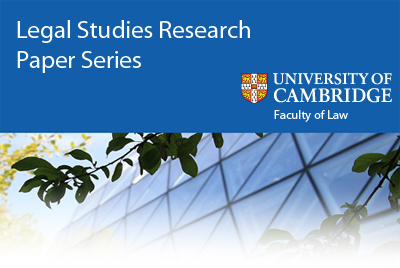 The Faculty has published the first edition of the University of Cambridge Faculty of Law Legal Studies Research Paper Series on SSRN: Volume 7 Number 1.
The Faculty has published the first edition of the University of Cambridge Faculty of Law Legal Studies Research Paper Series on SSRN: Volume 7 Number 1.
This issue includes the following articles:
Matthew Dyson: Hancock and Shankland [1986] AC 455 (59/2015)
During the miner’s strike of 1984-5, two miners dropped concrete objects onto the path of an incoming convoy bearing a strike-breaking miner. There, on Heads of the Valleys Road, under Rhymney Bridge, events were set in motion to force English law to redefine what it means to intend death on a charge of murder.
English law only sought technical doctrinal precision in its fault, or mens rea, from the middle of the twentieth century. Before then, a person was presumed to intend the natural and probable consequences of his actions, and until 1898, there were significant limits on what evidence the defendant could give about his or her mental state. Thereafter, English law needed a test for juries to use. Normally, a jury would be directed to use its “common sense” understanding of “intention”. However, there were some exceptional situations, where the defendant’s purpose was not death or grievous bodily harm and such situations required a special direction to the jury. This direction had been attempted by the House of Lords prior to Hancock and Shankland, indeed, only a year before, in R v Moloney. That direction in Moloney had asked the jury to look for intention by considering whether the outcome alleged to be intended was a “natural” consequence of the defendant’s acts and if the defendant knew that. If so, the jury might infer intention. Even so, this model direction was too simple, it left too much ambiguity in what constituted “natural” consequences. In Hancock and Shankland, the Court of Appeal had certified as a question of public importance whether this direction required amplification; the House of Lords replied affirmatively, but did not provide a direction containing it. Instead, they wiped clean the earlier encrustations of vocabulary such as “natural” and “probable”, temporarily removing any specific jury direction on intention. The space so created was immediately filled by the Court of Appeal in Nedrick in 1986 through a model direction, confirmed by the House of Lords in Woollin in 1999: the jury may find that the defendant intended the relevant consequence where she or he foresaw it as a virtual certainty and in fact it was a virtual certainty. In short, it was Hankcock and Shankland which made the modern law possible though itself failed to achieve it.
Jaka Kukavica & Veronika Fikfak: Strasbourg's U-Turn on Independence as Part of an Effective Investigation Under Article 2 (60/2015)
After McCann and Others v the United Kingdom, in which the European Court of Human Rights first read the procedural obligation of effective investigation into Article 2, Mustafa Tunç and Fecire Tunç is arguably one the most interesting decisions on the nature of the obligation to conduct an effective investigation in the Court’s recent history. Whilst the Court through its case-law has clarified that when individuals have been killed by the state or a private party, the Contracting Parties have to undertake an investigation under Article 2, which has to be independent, adequate, prompt, and publicly scrutinised, it remained unclear whether the element of independence had to meet criteria similar to those under Article 6, which guarantees a fair trial, or whether a lower standard was sufficient for an investigation to be considered effective in the context of Article 2. The Strasbourg court went back and forth on the issue (even adopting an absolutist approach in Al-Skeini and Others v the United Kingdom and it was not until Mustafa Tunç where the issue of independence under Article 2 was addressed head-on.
David Erdos: European Regulatory Interpretation of the Interface between Data Protection and Journalistic Freedom: An Incomplete and Imperfect Balancing Act? (61/2015)
Directive 95/46 required European Economic Area Member States to ensure a careful balancing between the inherently conflicting values of data protection and journalistic freedom of expression. Unfortunately, however, this was often not achieved during the transposition of the Directive into local law. At the same time, both Directive 95/46 and the Art. 7 of the EU Charter mandated Member States to set up supervisory Data Protection Authorities (DPAs) which in practice dominate the data protection landscape. In the light of this, EEA DPAs were surveyed on their understanding of the right to subject access and the practice of undercover political journalism, with the responses then compared to provisions in local data protection law. The results demonstrated that DPAs do seek a balance in this area even against contrary statute. Nevertheless, the balancing achieved often remains incomplete, normatively contestable, opaque and precarious. It is argued that, following the likely replacement of Directive 95/46 with a new Regulation, these challenges must be tackled through a combination of both legislative and regulatory action.
Nicholas McBride: Stephen A Smith on Duties and Liabilities (62/2015)
This brief paper outlines the significance of Stephen A Smith's work on the difference between duties and liabilities for our understanding of the law of obligations. The paper was written for a conference (yet to be held) in Hong Kong on 'Great Works in Private Law 1985-2015'.
Christopher Forsyth: ‘Blasphemy Against Basics’: Doctrine, Conceptual Reasoning and Certain Decisions of the UK Supreme Court (64/2015)
Using the conceit of Minerva J, a judge wise beyond all telling who administers justice above the Supreme Court concentrating on judicial review cases this paper argues that the abandonment of orthodox doctrine by the Supreme Court in particular on R (Cart) v Upper Tribunal [2011] UKSC 28, [2012] 1 AC 663 (on whether the Upper Tribunal was subject to judicial review) and Jones v First Tier Tribunal [2013] UKSC 19, [2013] 2 AC 48 (on the distinction between law and fact) is much to be regretted. When doctrine is replaced by judicial discretion the law is rendered unnecessarily uncertain and the legitimacy of the judiciary undermined. Minerva does not approve of judicial blasphemy against basics.
Interested readers can browse the Working Paper Series at SSRN, or sign up to subscribe to distributions of the the e-journal.


 Facebook
Facebook  X/Twitter
X/Twitter  Instagram
Instagram  YouTube
YouTube  Flickr
Flickr  LinkedIn
LinkedIn